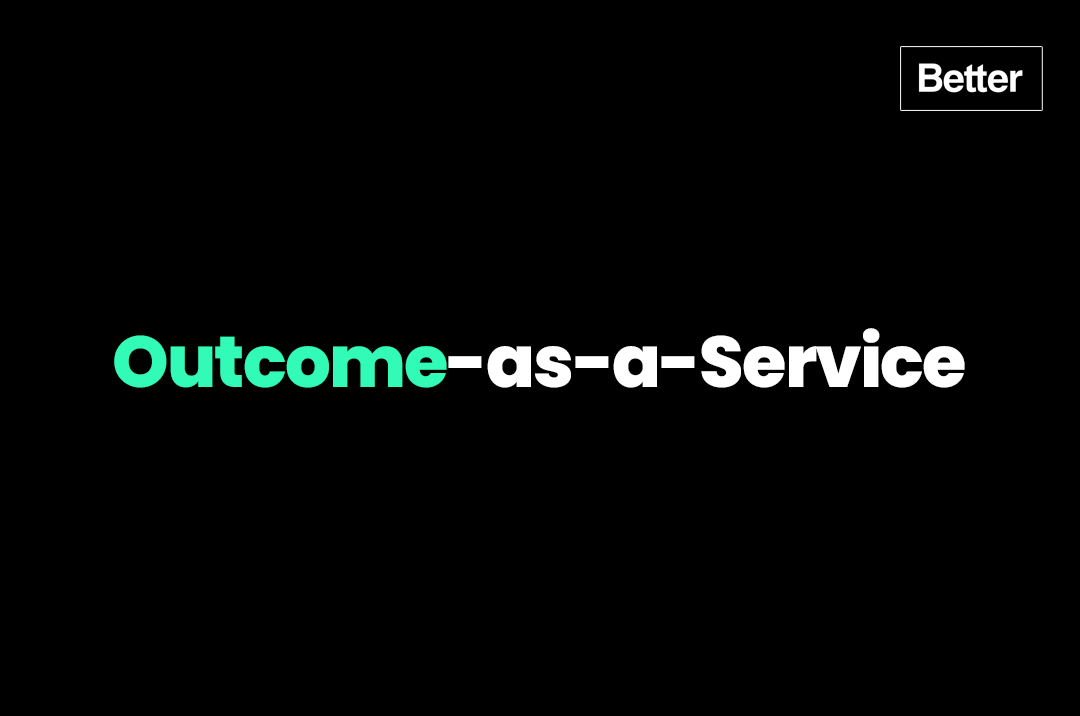Outcome-as-a-Service
AI-powered Outcome-as-a-Service will replace software and services as we know it today as enterprises choose tangible outcomes over yet another piece of software.

Humans used to do the work. Then we built software to help. Then we built SaaS to make that software easier to use. But the goal never changed: get the job done.
We didn’t buy Salesforce because we loved CRMs, we wanted more sales. We didn’t implement Workday for the fun of it, we needed org-wide HR coordination. Every layer of software, from on-prem to cloud, was a means to an end.
But something strange happened along the way: SaaS became the job. Setup, configuration, integrations, dashboards, training… over time, more and more human effort shifted from doing the real work to operating the tool designed to do the work.
AI breaks that cycle.
With AI, we’re not just getting better tools - we’re finally getting closer to what we always wanted: results. Not dashboards. Not notifications. Not workflows. Outcomes.
That’s the core of Outcome-as-a-Service. It’s not AI bolted onto SaaS. It’s AI that replaces SaaS — by doing the job and delivering the result.
You don't need a CRM - you want closed deals.
You don't need HR software - you want onboarding done.
You don’t need analytics tools - you want the insight and the action.
We started investing in this shift in 2022–2023, well before Copilots came along as AI bandaids to SaaS. But the real breakthrough isn’t copilots. It’s contracting for outcomes, not effort. And we believe OaaS will become the defining model for the next generation of software businesses.
This is what every enterprise buyer actually wants:
- Less SaaS sprawl.
- Fewer seats.
- More results.
Outcome-as-a-Service is not the evolution of SaaS — it’s the replacement. And it opens the door to a new generation of builders who think in outputs, not inputs.
What is Outcome-as-a-Service (OaaS)?
Outcome-as-a-Service (OaaS) is a business model that leverages AI to deliver specific, tangible outcomes directly to customers, bypassing the need for traditional software and service management. Instead of providing tools or platforms that require user intervention and management, OaaS delivers the end result that the user desires, fully automated by AI.
How does OaaS differ from traditional software and SaaS?
Traditional software requires users to manage installations, configurations, and updates, while SaaS simplifies this by offering software on a subscription basis, eliminating the need for on-premises management. OaaS goes a step further by removing the need for users to interact with software at all, instead providing the desired outcomes directly through AI automation.
Why might traditional software and SaaS providers struggle to compete with OaaS?
Traditional software and SaaS providers might struggle to compete with OaaS because OaaS eliminates the need for software management and interaction. It delivers results directly, making many of the features and benefits of traditional software and SaaS redundant. This fundamental shift challenges existing business models and value propositions.
How does OaaS address the core need for humans to "get work done"?
OaaS addresses the core need for humans to "get work done" by focusing on the desired outcomes rather than the tools used to achieve them. AI-powered OaaS solutions perform tasks autonomously, delivering results directly to users without requiring them to manage or interact with software, thus streamlining the process and saving time and effort.
What are thoughts on AI Agents and Results-as-a-Service?
AI Agents and Results-as-a-Service represent a paradigm shift where AI systems take on the role of performing tasks and delivering outcomes autonomously. This approach highlights the potential of AI to not only assist humans but to actually complete tasks and achieve results on their behalf, making traditional software interactions unnecessary.
In what ways does AI-powered OaaS go beyond the capabilities of SaaS?
AI-powered OaaS goes beyond the capabilities of SaaS by not just facilitating tasks but by completing them autonomously. While SaaS simplifies software management and access, OaaS eliminates the need for user involvement entirely, providing end-to-end solutions driven by AI that deliver the desired outcomes directly.
What potential does OaaS have for disrupting current business models?
OaaS has the potential to disrupt current business models by shifting the focus from product and service delivery to outcome delivery. This change reduces the need for traditional software and service management, challenging the value propositions of existing SaaS and software companies and creating opportunities for new, outcome-focused businesses.
How do AI and OaaS address the original reasons humans did work themselves?
AI and OaaS address the original reasons humans did work themselves by directly delivering the outcomes humans seek. Instead of providing tools to facilitate work, AI-powered OaaS performs the work autonomously, achieving the desired results without human intervention, thus fulfilling the core need for effective and efficient task completion.
How can enterprises leverage OaaS to achieve their desired outcomes more effectively?
Enterprises can leverage OaaS to achieve their desired outcomes more effectively by adopting AI-powered solutions that automate processes and deliver results directly. By focusing on the end results rather than the tools or processes, businesses can increase efficiency, reduce costs, and improve productivity.
Why is the concept of "outcome" central to the idea of OaaS?
The concept of "outcome" is central to the idea of OaaS because it shifts the focus from the means of achieving results to the results themselves. OaaS prioritizes delivering the specific outcomes that users need, bypassing the complexities of software and service management, thus directly addressing users' goals and needs.
What are some misconceptions about AI-powered OaaS?
Some misconceptions about AI-powered OaaS include the belief that it is merely an extension of SaaS or that it requires significant user management. In reality, OaaS represents a distinct model where AI autonomously delivers the desired outcomes, eliminating the need for traditional software interactions and management. Additionally, some may underestimate the potential of AI to handle complex tasks and deliver accurate results without human intervention.






